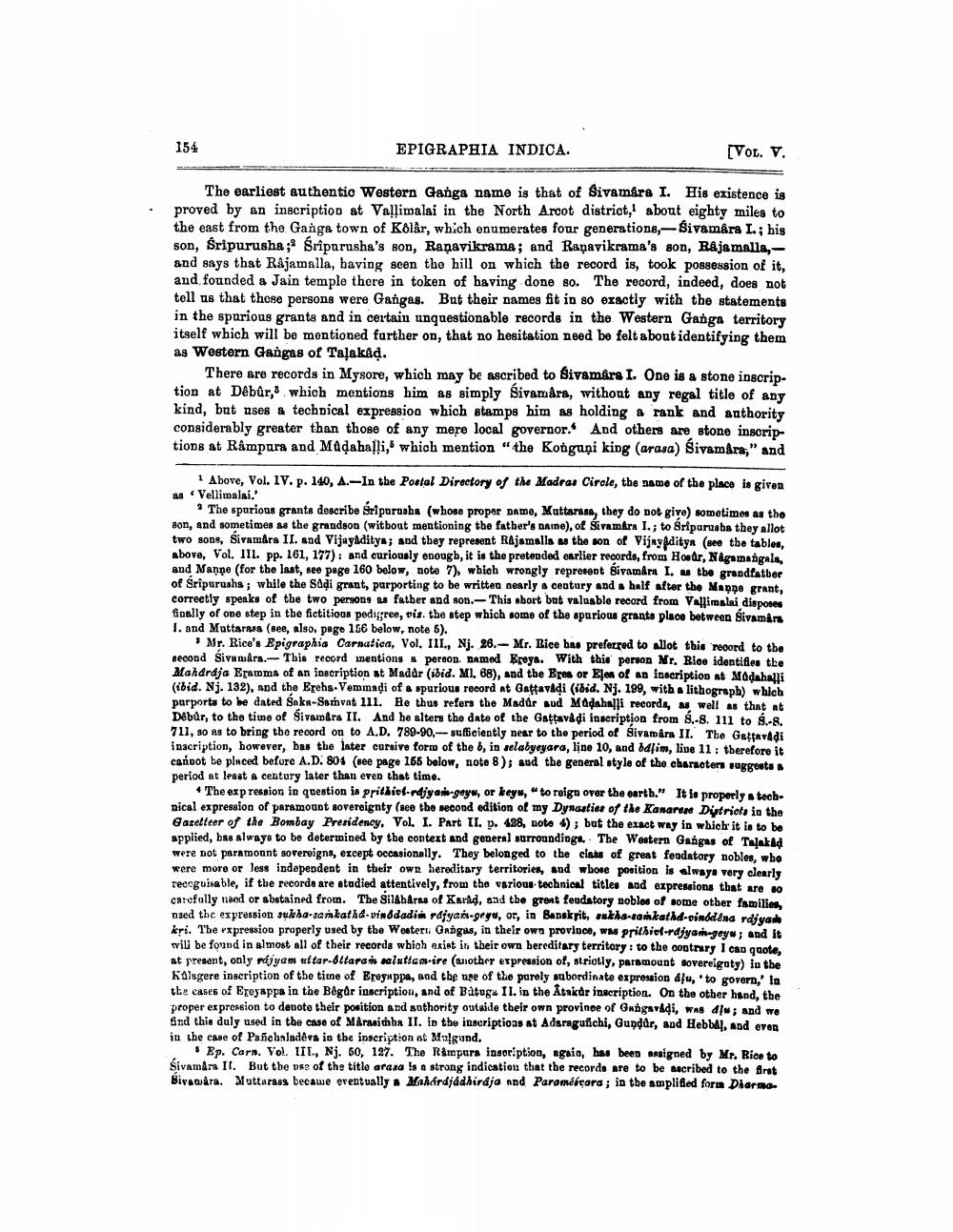________________
154
EPIGRAPHIA INDICA.
(VOL. V.
The earliegt authentio Western Ganga name is that of Sivamara I. His existence is proved by an inscription at Vallimalai in the North Arcot district,' about eighty miles to the east from the Ganga town of Kolår, which enumerates four generations, - Šivamara L.; his son, Sripurusha;' sripurusha's son, Raņavikrams; and Ranavikrama's son, Rajamalla,and says that Rajamalla, having seen the hill on which the record is, took possession of it, and founded a Jain temple there in token of having done so. The rooord, indeed, does not tell us that these persons were Gangas. But their names fit in so exactly with the statements in the sparious grants and in certain unquestionable records in the Western Ganga territory itself which will be mentioned further on, that no hesitation need be felt about identifying them as Western Gangas of Talakad.
There are records in Mysore, which may be ascribed to Sivaméra I. One is a stone inscription at Dêbûr, which mentions him as simply Sivamudra, without any regal title of any kind, but uses a technical expression which stamps him as holding a rank and authority considerably greater than those of any mere local governor. And others are stone inscriptions at Rampura and Madahalli, which mention " the Konguội king (arasa) Sivamara," and
1 Above, Vol. IV. p. 140, A.-In the Postal Directory of the Madras Circle, the name of the place is given as Vellimalai.'
The spurious grants describe sripuruaba (whose proper dame, Mattaris, they do not give) sometimes as the son, and sometimes as the grandson (without mentioning the father's Daine), of Sivamira I.; to Sripurusba they allot two sons, Sivamdrs II. and Vijayaditya; and they represent Rajsmells us the son of VijayAditya (see the tables, above, Vol. IIL. Pp. 161, 177): and curiously enougb, it is the pretended earlier records, from Howar, Nagamangala, and Manpe (for the last, see page 160 below, note 7), wbich wrongly represent Bivamaru I. u tbe grandfather of Sripurushs; while the Sadi grant, parporting to be written nearly a century and a half after the Mappe grant, correctly speaks of the two persons us father and son. This abort but valuable record from Vaflimalai disposes finally of one step in the fictitious podigree, vis, the step which some of the spurious granto place between sivaman 1. and Muttarasa (see, also, page 166 below, note 6).
Mr. Rice's Epigraphia Carnatica, Vol. III., Nj. 28.- Mr. Rice bas preferred to allot this record to the second sivamars. This record mentions # person. Damed Eroya. With this person Mr. Rice identifies the Mahdrdja Eramma of an inscription at Madar (ibid. Ml, B8), and the Bres or Elen of an inscription at Madahalli (ibid. Nj. 132), and the Ereha.Vommadi of a sparious record at Gattayadi (ibid. Nj. 199, with a lithograph) which parports to be dated Snka-Samvat 111. He thus refers the Maddr sud Madahali records, a well as that at Debůr, to the time of Sivambra II. And he alters the date of the Gattava di inscription from 8.-8. 111 to 5.-8. 711, so as to bring the record on to A.D. 789-90,--sufficiently Dear to the period of Sivamara II. The Gattaradi inscription, however, bas the later cursive form of the 6, in selabyeyara, line 10, and bdim, line 11: therefore it cannot be placed before A.D. 80$ (nee page 166 below, note 8); aud the general style of the characters suggests period at least a century later than even that time.
The expression in question is prithiof.ndjyan-goyw, or keys, "to reign over the earth." It is properly a technical expression of paramount sovereignty (see the second edition of my Dynasties of the Kanaren Dytricts in the Gazetteer of the Bombay Presidency. Vol. I. Part II. D. 428, noto ), but the exact way in which it is to be applied, bas alwayo to be determined by the context and general surrounding. The Western Gangas of Talakad were not paramount sovereigns, except occasionally. They belonged to the class of great feudatory nobles, who were more or less independent in their own hereditary territories, and whose position is always very clearly recognisable, if the records are studied attentively, from the various technical titles and expressions that are 10 carefully need or abstained from. The SilAbarns of Karad, sad the great fondatory nobles of some other families need the expression suka-sankathd-vinodadisi rdjyak-geys, or, in Banskrit, rukhstankathd-vinod na rdjyante kri. The expression properly used by the Westeri. Gangas, in their own province, w prilbie-rdjyan geys; and it will be found in almost all of their records which exist in their own bereditary territory: to the contrary I can quote, at present, only májyam teftar-Oltara i salutiam-ire (another expression of, striotly, paramount sovereigoty) in the Kalsgere inscription of the time of Erogappa, and the use of the purely subordinato expression áfu, to govern,' in the cases of Ereyappa in the Begär inscription, and of Batoga II. in the Atukar inscription. On the other hand, the proper expression to denote their position and authority outside their own province of Gangavadi, was alw; and we And this duly used in the case of Marasitha II. in the inscriptioas at Adaragutichi, Gundur, and Hebbal, and even in the case of Panobaladers in the inscription at Malgund.
Ep. Carn. Vol. III, Nj. 60, 127. The Rampurs inscription, agaio, has been resigned by Mr. Rice to Sivamara Il. But the ure of the title arana is a strong indication that the records are to be ascribed to the Brat Bivadåra. Muttarass became eventually ~ Mahardjádhiraja and Paramé cars; in the amplified form Dharma




